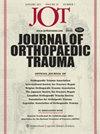The Effects of Unitizing Nail-Plate Constructs in Distal Femur Fractures: A Biomechanical Study
IF 1.6
3区 医学
Q3 ORTHOPEDICS
引用次数: 0
Abstract
To assess the biomechanical differences between linked and unlinked constructs in young and osteoporotic cadavers in addition to osteoporotic sawbones. Intraarticular distal femur fractures with comminuted metaphyseal regions were created in three young matched pair cadavers, three osteoporotic matched pair cadavers, and six osteoporotic sawbones. Precontoured distal femur locking plates were placed in addition to a standardized retrograde nail, with unitized constructs having one 4.5 mm locking screw placed distally through the nail. Nonunitized constructs had seven 4.5 mm locking screws placed through the plate around the nail, with one 5 mm distal interlock placed through the nail alone. Cadaveric specimens were subjected to axial fatigue loads between 150 and 1500 N (R Ratio = 10) with 1 Hx frequency for 10,000 cycles. Sawbones were axially loaded at 50% of the ultimate load for fatigue testing to achieve runout, with testing performed with 30 and 300 N (R Ratio = 10) loads with 1 Hz frequency for 10,000 cycles. In young cadavers, there was no difference in the mean cyclic displacement of the unitized constructs (1.51 ± 0.62mm) compared to the non-unitized constructs (1.34 ± 0.47mm) (Figure 4A), (p = 0.722). In osteoporotic cadavers, there was no difference in the mean cyclic displacement of the unitized constructs (2.46 ± 0.47mm) compared to the non-unitized constructs (2.91 ± 1.49mm) (p=0.639). There was statistically no significant difference in cyclic displacement between the unitized and non-unitized groups in osteoporotic sawbones(p = 0.181) Linked constructs did not demonstrate increased axial stiffness or decreased cyclical displacement in comparison to unlinked constructs in young cadaveric specimens, osteoporotic cadaveric specimens, or osteoporotic sawbones.股骨远端骨折中单元化钉板结构的效果:生物力学研究
评估年轻和骨质疏松尸体以及骨质疏松锯骨中连接和非连接结构的生物力学差异。 在三具年轻的配对尸体、三具骨质疏松的配对尸体和六块骨质疏松的锯骨中创建了粉碎性骨骺区的股骨远端关节内骨折。除了标准化的逆行钉外,还放置了预弯股骨远端锁定钢板,单位化结构的远端通过钢钉放置了一颗 4.5 毫米锁定螺钉。非单元化结构则在钢板上围绕钢钉放置了七颗 4.5 毫米的锁定螺钉,仅在钢钉上放置了一颗 5 毫米的远端锁定螺钉。尸体标本承受的轴向疲劳载荷在 150 到 1500 N 之间(R Ratio = 10),频率为 1 Hx,循环次数为 10,000 次。在疲劳测试中,锯骨的轴向载荷为极限载荷的 50%,以实现跳动,测试以 30 和 300 N(R 比 = 10)的载荷和 1 Hz 的频率进行,循环 10,000 次。 在年轻尸体中,单元化结构的平均循环位移(1.51 ± 0.62 毫米)与非单元化结构的平均循环位移(1.34 ± 0.47 毫米)相比没有差异(图 4A),(p = 0.722)。在骨质疏松尸体中,单元化结构的平均周期位移(2.46 ± 0.47mm)与非单元化结构的平均周期位移(2.91 ± 1.49mm)相比没有差异(p=0.639)。在骨质疏松的锯骨中,单元化组和非单元化组的周期位移在统计学上没有明显差异(p=0.181)。 在年轻的尸体标本、骨质疏松的尸体标本或骨质疏松的锯骨中,与非链接结构相比,链接结构没有显示出轴向刚度的增加或周期位移的减少。
本文章由计算机程序翻译,如有差异,请以英文原文为准。
求助全文
约1分钟内获得全文
求助全文
来源期刊

Journal of Orthopaedic Trauma
医学-运动科学
CiteScore
3.90
自引率
8.70%
发文量
396
审稿时长
3-8 weeks
期刊介绍:
Journal of Orthopaedic Trauma is devoted exclusively to the diagnosis and management of hard and soft tissue trauma, including injuries to bone, muscle, ligament, and tendons, as well as spinal cord injuries. Under the guidance of a distinguished international board of editors, the journal provides the most current information on diagnostic techniques, new and improved surgical instruments and procedures, surgical implants and prosthetic devices, bioplastics and biometals; and physical therapy and rehabilitation.
 求助内容:
求助内容: 应助结果提醒方式:
应助结果提醒方式:


